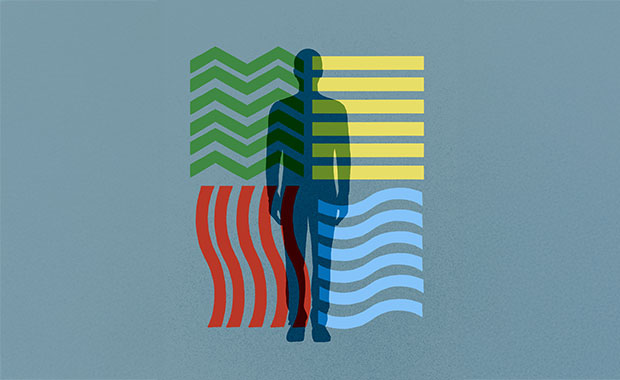Behavioral health facility design requires a distinct approach that considers the unique needs of patients who might be navigating heightened emotional, psychological, or sensory sensitivities. Health systems have come to recognize the importance of thoughtful design in these settings, prioritizing design strategies that reduce stress, promote calm, and support safety.
Biophilic design, which aims to integrate natural themes and elements into the built environment, has emerged as one of the most promising ways to improve behavioral health spaces because of its ability to reduce stress, support emotional regulation, and foster a sense of safety and connection—all of which are critical in these care settings.
While traditionally understood to be natural light and images of nature, contemporary biophilic design goes beyond the surface level, incorporating patterns, textures, and psychological principles that mimic conventions seen in nature.
Principles of biophilic design
Biophilic design centers on the idea that humans have an intrinsic evolutionary connection to nature, with the goal to harness this tie to enhance healing environments. Applying biophilic design principles in any design leads to a positive reaction in the sympathetic and parasympathetic nervous systems, which control inflammation, the flight/fight/freeze response, digestive processes, and blood pressure, among others
When designers create environments that help patients maintain their physical equilibrium, the person’s cognitive state receives less strain, which ultimately reduces the likelihood of self-harm, aggressive behavior, or emotional outbursts. While harmful to patients, these incidents also affect others by disrupting the therapeutic environment as well as placing added strain on staff.
Another viewpoint that supports this connection to nature comes from principles of psychology. For example, Swiss psychiatrist and psychoanalyst Carl Jung’s theory of the “collective unconscious” suggests that we’re inherently connected to nature on a deeper, psychological level. Drawing on this concept, project teams can understand the need to create designs for inpatient, outpatient, and crisis units that feel less institutional and are more focused on helping patients feel safe and supported as they move through their healing journey.
Going beyond greenery and natural light
Behavioral health settings may house patients experiencing a variety of conditions, including neurodivergence, addiction disorders, cognitive decline, and physical disabilities. These variables necessitate a design approach that is flexible, empathetic, and adaptable to users’ needs.
Blending nature-inspired elements with practical safety measures provides a means of integrating biophilic principles that are responsive to these needs. For example, the use of rounded or obtuse angle corners on furniture and counters is a small detail that also aligns with forms, such as hills and trees, that we find in nature. This feature can also be incorporated into larger, more prominent architectural elements, such as ceilings and walls, to make the space feel both subconsciously soothing and less clinical.
Further drawing on nature-inspired design principles, the horizon is naturally less saturated than the foreground because there is more atmosphere between a person and the landscape. Humans intrinsically know this, so the simple act of defining the end of a space with a color helps a person’s brain interpret a pattern they already know by heart.
Take, for example, a patient on medication that alters their cognitive state. In this instance, subconscious instincts may cause immediate feelings of stress or panic. Implementing clear wayfinding techniques that draw on patterns of recognition found in nature can reduce disorientation.
This idea is also exemplified in applications of the prospect-refuge theory, which states that people feel most comfortable in spaces where they can observe their surroundings (prospect), while having the option to retreat to a safer, more private space (refuge). In a behavioral health facility, project teams can design secluded booths or nooks within a communal space, which allow patients to be social and observe their surroundings while feeling protected and secure.
Sensory considerations for behavioral health patients
Biophilic design also includes sensory considerations such as lighting and acoustics, as these elements greatly influence how individuals interact with and feel in a space. This mirrors the way natural environments provide a range of sensory stimuli that support mental well-being.
Intentionality in creating sensory-rich elements allows for a bespoke treatment for patients to regulate their emotions. For example, a patient’s outburst can create a domino effect within group settings. Therefore, sound suppression and mitigation through acoustic materials or partitions should be addressed and coordinated with practitioners who understand their patient population.
In behavioral treatment spaces, quiet can be just as, or more, impactful than noise. Patients dealing with sensory sensitivities or those in mental distress might find high levels of noise overwhelming or extreme silence unsettling. Biophilic design seeks to create balanced, restorative sensory environments like those found in nature—neither overstimulating nor lacking stimulus but tuned to maximize human
Additionally, lighting control and customization can help decrease sensory overload. Dimmable or light temperature-tuning fixtures controlled by staff to meet patient-specific needs can de-escalate a situation. Coordination with facility staff and engineering consultants to provide these options with behavioral health-appropriate fixtures is critical.
Color palettes in behavioral health settings
Design teams should also discuss stimulation through color vibrancy with practitioners. Behavioral health research is changing daily, and there are many ways to interpret color and the feelings that it might invoke. While many designers use earthy tones in behavioral health facilities to help calm the senses, certain tones, whether warm or cool, can have different effects.
For example, research by Bradley E. Karlin and Robert A. Zeiss published by the National Institute of Health outlines color directives, including the competing goals of stimulating colors for patients who are depressed without overstimulating easily agitated patients. Clinicians should weigh in on if they want to implement a saturated, muted, or in-between color palette.
Biophilic tones help rectify this as they typically aren’t overstimulating. Incorporating a variety of tones in the same color harkens back to natural elements, like ripples in a stream, or the different variations of brown when looking closely at tree bark.
Texture on wall installations or furniture can also be a powerful tool for de-escalation by engaging the senses and providing a distraction from anxiety. But it should be noted that it requires close consideration and buy-in from practitioners and infection control. Not all materials are suitable for these behavioral health environments; specifically, those that are difficult to sanitize or might be misused by patients during a crisis.
Commonly, specific rooms are assigned for sensory use so cleaning and safety factors can be controlled to one space. Other important design considerations for these rooms include the durability and cleanability of materials, tamper-resistant finishings, and avoiding elements that might ultimately pose a risk.
Working with a facility on their safety risk assessment should include discussion about selection of materials, furnishings, and surfaces to align with safety protocols and procedures.
Designing for healthcare staff
The design of supportive, wellness-focused environments should not be forgotten when addressing staff needs, as well. Nurses’ stations, which are typical activity hubs within a facility, should offer clear sightlines for observation while allowing for separation between patients and staff. The removal of physical barriers to sight such as partitions encourages a sense of trust and connection between patients and staff.
It’s also important for caretakers to have areas of respite to allow them to recharge, which, in turn, can help staff provide better care and higher levels of attention for their patients. Spaces should be easy to navigate, interact with, and provide cognitive escape from the taxing activities of the day.
In addition to behind-the-scenes respite areas, ergonomic work stations can also serve nurses’ needs with comfortable seating and spaces that are proportional to the human body but not claustrophobic
Future planning for behavioral health environments
Incorporating all these factors requires careful review and planning in behavioral health environments where every physical element must avoid causing excessive stimulation for the safety and well-being of patients. Project teams can collaborate with the clinical staff to understand safety, patient population, and clinical function to help identify what design features to prioritize.
Recognizing the diverse needs of both patients and staff, integrating sensory-rich elements, and being aware of unseen experiential factors, such as triggering stimuli, can lead to more informed design decisions and patient prosperity.
Sarah Harvey, CHID, CID, EDAC, NCIDQ, is a senior interior designer at FCA (Philadelphia) and can be reached at [email protected]. Tory Silverwood, NCIDQ, is an interior designer at FCA and can be reached at [email protected].













